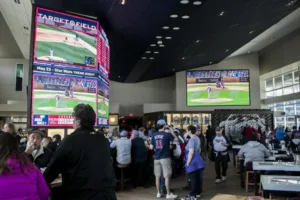A few weeks ago, I detailed the on-again/off-again plans of Foxconn chairman Terry Gou to build an LCD fab in Mt. Pleasant, Wisconsin – an attempt largely viewed as an attempt to stay on the good side of the current administration in Washington and perhaps avoid costly tariffs on his finished displays and mobile devices, which are used by millions of Americans every day.

Now, politics and displays have crossed paths again. A press release from Futuresource Consulting details how, at the recent Macroblock LED Display Conference in Shenzhen, China, Futuresource senior market analyst Hope Lee predicted that narrow pixel pitch (NPP) LED videowalls will have overtaken LCD video walls in annual revenues by 2021.
That is, unless the proposed tariffs on everything coming from China go into effect later this year. To quote from the release, “As the US-China trade war intensifies and political indications suggest a continuing period of punitive tariffs, Chinese companies are exploring ways to accelerate their expansion into Southeast Asia, the Middle East and Latin America.”
The problem is, the U.S. market is one of the largest for LED walls and signage and not easily dismissed. And tariffs on LED tiles, blocks, and complete walls coming from China would only benefit one U.S. company, South Dakota-based Daktronics, which focuses more on outdoor LED signage and big stadium and arena displays.
According to Lee, “Upwards of 500 companies in China have R&D and manufacturing capabilities for LED video walls. With all this competition, the sector is going into overdrive and vendors are not only considering new international markets, but also placing renewed focus on durability, reduced power consumption and innovation.”
Fine-pitch LEDs a/k/a NPP LEDs are the fastest-growing category of LED displays. Generally categorized as anything up to 2.5mm, fine pitch LED sales in 2019 will reach 1.1 million square meters, up from 800,000 square meters in 2018, for a total of $5.1 billion in revenue, according to a recent forecast by IHS Markit. By 2023, IHS Markit predicts area shipments will have reached 2 million square meters, generating $7.5 billion in annual revenue. And the U.S. market will be a big part of that fiscal picture.
We’ve already seen how some Chinese display manufacturers have come up with workarounds. TCL led all manufacturers in TV shipments to the U.S. for the first quarter of 2019, besting even perennial champ Samsung by a substantial margin. Why? Because the company anticipated a new round of tariffs would hammer sales, particularly in the fourth quarter as the holiday selling season approached.
You can expect much the same tactics from Chinese LED manufacturers that sell direct through U.S. subsidiaries, like Absen, Rowe, and Unilumin. As I write this, it’s likely they have increased shipments of LED tiles and panels to get in under the wire. You may also see something unusual, and that would be aggressive price reductions to essentially negate the effects of additional duties.
The question is, how will tariffs impact sales of LED walls and tiles from middlemen like Christie, Barco, Leyard Planar, and Digital Projection? Will they be able to secure exemptions, especially the latter two companies that have substantial stateside offices? Will Daktronics see any additional sales in 2020, as a result of these tariffs?
Stay tuned… (PP)

